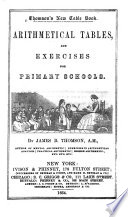 | James Bates Thomson - 1847 - 426 páginas
...5 If. MULTIPLICATION OF FRACTIONS. 2O9. We have seen that multiplying by a whole number, is taking the multiplicand as many times as there are units in the multiplier. (Art. 82.) On the other hand, If the multiplier is only a part of a unit, it is plain we must take... | |
 | Jeremiah Day, James Bates Thomson - 1848 - 264 páginas
...considered positive. (Art. 162.a.) D be asked, can geometrical quantities be multiplied into each other 1 One of the factors, in multiplication, is always to be considered as a number. The operation consists in repeating the multiplicand as many times as there are units in the multiplier.... | |
 | James Bates Thomson - 1848 - 434 páginas
...[SECT. VII. MULTIPLICATION OP FRACTIONS. 209. We have seen that multiplying by a whole number, is taking the multiplicand as many times as there are units in the multiplier. (Art. 82.) On the other hand. If the multiplier is only a part of a unit, it is plain we must take... | |
 | Jeremiah Day - 1849 - 350 páginas
...multiplied into each other? One of the factors, in multiplication, is always to be considered as & number. (Art. 91.) The operation consists in repeating the multiplicand as many times as there are uniti in the multiplier. How then can a line, a surface, or a solid, become a multiplier 1 To explain... | |
 | Dana Pond Colburn, George Augustus Walton - 1849 - 110 páginas
...product in multiplication may be regarded as a number representing the sum which would result from taking the multiplicand as many times as there are units in the multiplier. By division we can determine two distinct things ; first, into how many parts of a given size a given... | |
 | Charles Davies - 1850 - 412 páginas
...multiplicand, and make as many such ]****** represent the number of units which result from taking the multiplicand as many times as there are units in the multiplier. Let us now change the multiplier into the multiplicand, and let the multiplicand become the multiplier.... | |
 | Thomas H. Palmer - 1854 - 368 páginas
...multiplying by •£ or by 5)5, &c., really is division. For multiplication, it will be remembered, is taking the multiplicand as many times as there are units in the multiplier. Exercises for the Slate and Black-board. 1. What will 7 yds. 3 qr. 2 na. of cloth come to, at £2 2s.... | |
 | Thomas H. Palmer - 1854 - 356 páginas
...multiplying by i or by ^V, &c., really is division. For multiplication, it will be remembered, is taking the multiplicand as many times as there are units in the multiplier. . Exercises for the Slate and Black-board. 1. What will 7 yds. 3 qr. 2 na. of cloth come to, at £2... | |
 | James Bates Thomson - 1854 - 106 páginas
...? Ans. Take the multiplicand twice. Thus, 4X2 = 8. 3. How multiply by any whole number ? Ans. TAKE the multiplicand as many times as there are units in the multiplier. 4. Hoqr then do you multiply by 1 half? Ans. Take 1 halflhe multiplicand once. Thus, 6 X 4=3. 5. How... | |
 | 1855 - 424 páginas
...calculations, there is frequent occasion for multiplication, division, involution, etc. But how, it may be asked, can geometrical quantities be multiplied into...multiplication is always to be considered as a number. The operation consists in repeating the multiplicand as many times as there are units in the multiplier.... | |
| |